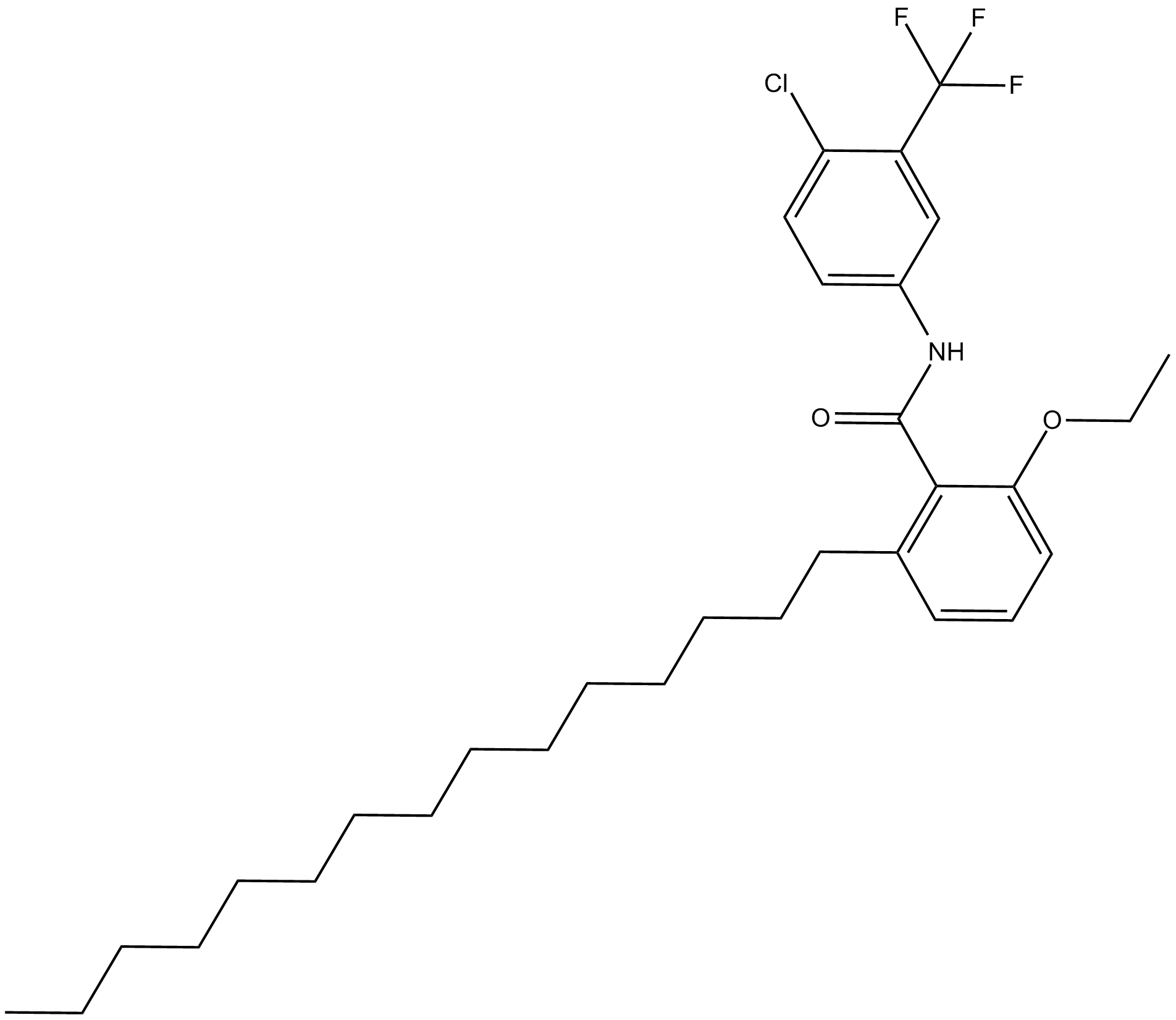CTPB |
| Catalog No.GC14524 |
Le CTPB est un bon activateur de l'enzyme p300 histone acétyl transférase (HAT).
Products are for research use only. Not for human use. We do not sell to patients.

Cas No.: 586976-24-1
Sample solution is provided at 25 µL, 10mM.
CTPB is a selective activator of p300 HAT activity [1].
CREB binding protein (CBP) and E1A binding protein p300, also known as p300 are functionally related transcriptional co-activators (CoAs) and histone acetyltransferases (HATs). The p300/CBP is a global transcriptional coactivator, which plays a critical role in cell cycle control, differentiation, and apoptosis. Mutations in p300/CBP are associated with different human cancers and other human diseases [1][2].
CTPB, also known as N-(4-chloro-3-trifluoromethyl-phenyl)-2-ethoxy-6-pentadecyl-benza-mide, is an amide derivative that selectively activates p300 HAT activity. CTPB directly binds p300 [2]. CTPB exhibited an enhancement in the p300 HAT activity concentration-dependently with maximal activation at 275 μM. In the presence of p300, CTPB resulted in the gradual increase in the acetylation of both histones H3 and H4, peaking at 200 μM. Further increase in the concentration of CTPB reduced the HAT activity, could be due to an alteration in the reaction condition affecting the efficiency of the HAT. CTPB didn’t alter PCAF HAT or histone deacetylase activity [1].
References:
[1]. Balasubramanyam K, Swaminathan V, Ranganathan A, et al. Small molecule modulators of histone acetyltransferase p300. J Biol Chem. 2003 May 23;278(21):19134-40.
[2]. Devipriya B, Parameswari AR, Rajalakshmi G, et al. Exploring the binding affinities of p300 enzyme activators CTPB and CTB using docking method. Indian J Biochem Biophys. 2010 Dec;47(6):364-9.
| Cas No. | 586976-24-1 | SDF | |
| Chemical Name | N-[4-chloro-3-(trifluoromethyl)phenyl]-2-ethoxy-6-pentadecyl-benzamide | ||
| Canonical SMILES | ClC1=CC=C(NC(C2=C(CCCCCCCCCCCCCCC)C=CC=C2OCC)=O)C=C1C(F)(F)F | ||
| Formula | C31H43ClF3NO2 | M.Wt | 554.1 |
| Solubility | ≤15mg/ml in ethanol;20mg/ml in DMSO;30mg/ml in dimethyl formamide | Storage | Store at -20°C |
| General tips | Please select the appropriate solvent to prepare the stock solution according to the
solubility of the product in different solvents; once the solution is prepared, please store it in
separate packages to avoid product failure caused by repeated freezing and thawing.Storage method
and period of the stock solution: When stored at -80°C, please use it within 6 months; when stored
at -20°C, please use it within 1 month. To increase solubility, heat the tube to 37°C and then oscillate in an ultrasonic bath for some time. |
||
| Shipping Condition | Evaluation sample solution: shipped with blue ice. All other sizes available: with RT, or with Blue Ice upon request. | ||
| Prepare stock solution | |||

|
1 mg | 5 mg | 10 mg |
| 1 mM | 1.8047 mL | 9.0236 mL | 18.0473 mL |
| 5 mM | 0.3609 mL | 1.8047 mL | 3.6095 mL |
| 10 mM | 0.1805 mL | 0.9024 mL | 1.8047 mL |
Step 1: Enter information below (Recommended: An additional animal making an allowance for loss during the experiment)
 g
g
 μL
μL

Step 2: Enter the in vivo formulation (This is only the calculator, not formulation. Please contact us first if there is no in vivo formulation at the solubility Section.)
Calculation results:
Working concentration: mg/ml;
Method for preparing DMSO master liquid: mg drug pre-dissolved in μL DMSO ( Master liquid concentration mg/mL, Please contact us first if the concentration exceeds the DMSO solubility of the batch of drug. )
Method for preparing in vivo formulation: Take μL DMSO master liquid, next addμL PEG300, mix and clarify, next addμL Tween 80, mix and clarify, next add μL ddH2O, mix and clarify.
Method for preparing in vivo formulation: Take μL DMSO master liquid, next add μL Corn oil, mix and clarify.
Note: 1. Please make sure the liquid is clear before adding the next solvent.
2. Be sure to add the solvent(s) in order. You must ensure that the solution obtained, in the previous addition, is a clear solution before proceeding to add the next solvent. Physical methods such as vortex, ultrasound or hot water bath can be used to aid dissolving.
3. All of the above co-solvents are available for purchase on the GlpBio website.
Quality Control & SDS
- View current batch:
- Purity: >98.00%
- COA (Certificate Of Analysis)
- SDS (Safety Data Sheet)
- Datasheet
Average Rating: 5 (Based on Reviews and 6 reference(s) in Google Scholar.)
GLPBIO products are for RESEARCH USE ONLY. Please make sure your review or question is research based.
Required fields are marked with *



















